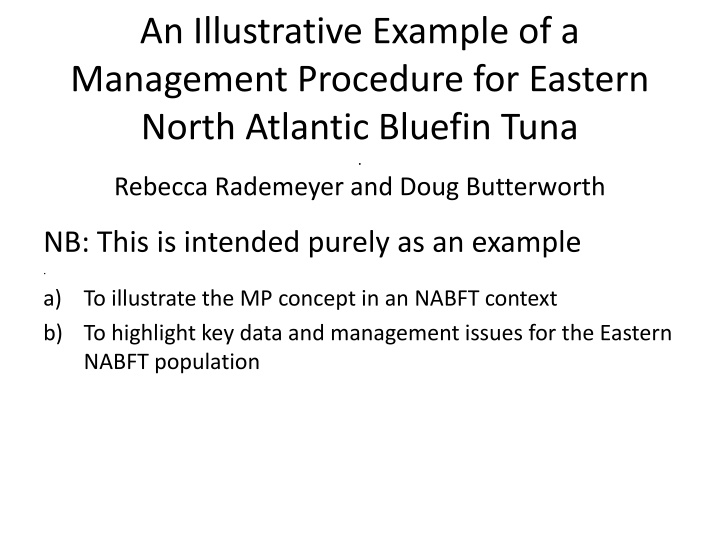
Eastern North Atlantic Bluefin Tuna Management Procedure Example
Explore an illustrative example of a management procedure for the Eastern North Atlantic Bluefin Tuna population, addressing key data and management issues such as recruitment fluctuations and adapting to recent data challenges. The example includes alternative assessments, catch projections, and a candidate management procedure, offering insights into sustainable fisheries management strategies.
Download Presentation

Please find below an Image/Link to download the presentation.
The content on the website is provided AS IS for your information and personal use only. It may not be sold, licensed, or shared on other websites without obtaining consent from the author. If you encounter any issues during the download, it is possible that the publisher has removed the file from their server.
You are allowed to download the files provided on this website for personal or commercial use, subject to the condition that they are used lawfully. All files are the property of their respective owners.
The content on the website is provided AS IS for your information and personal use only. It may not be sold, licensed, or shared on other websites without obtaining consent from the author.
E N D
Presentation Transcript
An Illustrative Example of a Management Procedure for Eastern North Atlantic Bluefin Tuna . Rebecca Rademeyer and Doug Butterworth NB: This is intended purely as an example . a) To illustrate the MP concept in an NABFT context b) To highlight key data and management issues for the Eastern NABFT population
Eastern bluefin tuna: Reference Case Problems: 1) Periods of low and high recruitment 2) Doesn t fit recent high data
Eastern bluefin tuna: Four OMs Four OMs (alternative assessments): 1) RC
Eastern bluefin tuna: Four OMs Four OMs (alternative assessments): 1) RC 2) S1: Upweight recent data (5x for 2010+ for JLL and larval indices)
Eastern bluefin tuna: Four OMs Four OMs (alternative assessments): 1) RC 2) S1: Upweight recent data (5x for 2010+ for JLL and larval indices) 3) S2a: Regime shift (1983), continue with high recruitment in the future 4) S2b: Same as S2a; change is in the future (go back to low recruitment in 2020)
Eastern bluefin tuna: Four OMs Four OMs (alternative assessments): 1) RC 2) S1: Upweight recent data (5x for 2010+ for JLL and larval indices) 3) S2a: Regime shift (1983), continue with high recruitment in the future 4) S2b: Same as S2a; change is in the future (go back to low recruitment in 2020)
Eastern bluefin tuna: Four OMs Constant catch projections (0, 15000t and 30 000t), deterministic Catch taken to be: 13 500t, 16 142t, 19 296t and 23 155t for 2014 to 2017
Eastern bluefin tuna: Candidate Management Procedure (CMP) J y = + + 1 1 TAC TAC s 1 / / y y up down y up down J targ Depends on average slope of indices (last 10 years data) Depends on average level of indices relative to a target (last 5 years data) and are tuning parameters, then can take on different values whether the slope (or level) (here up=0.03, down=0.15, up=0.03 and down=0.15) 2) Indices used: Japan Longline CPUE, larval index of spawning biomass 3) Can include constraint on maximum interannual change in TAC (here +-15%) 4) Can include cap on TAC (here: no cap, cap of 30 000t and cap of 40 000t) 5) The target level for abundance Jtargis set here to 50% of the average for S2a and S2b in the absence of catches 1)
Eastern bluefin tuna: Stochastic projections under CMP1 with 40 000t cap CV=0.78 CV=0.77 CV=0.72 CV=0.72 CV=0.87 CV=0.83 CV=0.83 CV=0.75
Eastern bluefin tuna: Stochastic projections under CMP1 with 30 000t cap CV=0.78 CV=0.77 CV=0.72 CV=0.72 CV=0.87 CV=0.83 CV=0.83 CV=0.75
Eastern bluefin tuna: Comparison of CMP1 with no cap, cap of 30 000t and cap of 40 000t
Eastern bluefin tuna: CMP2: Additional decrease if indices fall below specified level J y 0 for . 0 75 J targ J y linear between and % 0 30 % for 0.70 . 0 75 J = targ D J y y 3 . 0 0.40 . 0 75 TAC y J targ J y 0 . 1 4 . 0 J targ
Eastern bluefin tuna: Comparison of CMP1 and CMP2 (extra decrease), both with 40 000t cap
Eastern bluefin tuna: Comparison of CMP1 and CMP2 (extra decrease), both with 30 000t cap
Eastern bluefin tuna: Indices projections for S2b note how noisy
Eastern bluefin tuna: Indices projections for S2b note how noisy
Eastern bluefin tuna: Indices projections for S2b note how noisy
Whats to note and to do? In taking ICCAT bluefin MP process further, carefully consider: a) What indices to use for MP input b) The error structure for those indices c) Possible future recruitment scenarios and their plausibilities Consider potential for improvement by adding further indices e.g. for recruitment (as for SBT) NB: This is intended only as an EXAMPLE; it is for ILLUSTRATIVE purposes only!!
MPs for Bluefin Where next? 1) Data for conditioning operating models 2) Data series to serve as MP inputs a) Selection b) Specification of error structure 3) Specification of future recruitment scenarios 4) Agreement of process to accept conditioning as satisfactory for baseline trials 5) Specification of full set of robustness trials 6) Conditioning of trials 7) Is the first step: a) populations, or b) Separate MPs based on single stock assessments (operating models) for west and east, with a mixing model used for a robustness test? An ocean wide single MP covering both west and east spawning






















